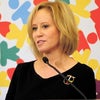Last fall, I had the privilege of teaching McGill University’s first-ever Capstone Seminar on social isolation and connectedness. It was an amazing opportunity—and as a first-time teacher, I was nervous at the semester’s outset. What if I couldn’t get discussion going? What if my students looked bored? Even though most of them were international studies majors, they didn’t all know one another. How could I foster rapport so that we were a class going forward together?
After a few sessions, I decided to get creative—literally. I opened one of our weekly discussions with two poems: Lao Tzu’s “If there is to be peace in the world,” and “The First Peace,” by Black Elk of the Oglala Lakota (Sioux).
Afterwards, one of my students came to see me and thanked me for starting that way. She said it was really effective to have such a moment. It grounded the class and brought us all together.
From that point on, we almost always began with a moment of shared creativity—a song by Leonard Cohen, a poem by Margaret Walker, a music video by Elvis Costello, a speech by Dr. Martin Luther King, Jr. Our “Creativity Moment” was a time for inspiration, reflection, and communion; a chance to connect what we were studying and discussing with what was happening inside ourselves and inside the room.
Again and again, my students expressed how much it meant to them. I was thrilled by their reactions—but not at all surprised. I’ve always believed that creativity and the imagination are pathways to belonging. Whether or not we possess artistic gifts, everyone has creativity within them. And when we can find our voice through creativity, we can communicate our true selves; just as, by the same token, creativity offers a bridge for us all to relate to one another.
Moreover, creativity—by underscoring our shared humanity—empowers even as it equalizes.
As the J.W. McConnell Family Foundation in Montreal, Canada, has noted, “Providing access to means of artistic expression can enable marginalized individuals and groups to feel valued and enabled, making them visible to themselves and to one another and to the broader society.”
And, last year, a policy briefing from the UK’s What Works Centre for Wellbeing shared the evidence they found about the impact of music and singing on people’s lives. It turns out that regular opportunities for music and singing have meaningful benefits for a range of populations. For older people in particular, singing in a group “can enhance morale and mental health-related quality of life and reduce loneliness, anxiety and depression.”
In fact, every form of creative expression creates powerful opportunities for connection.
I think of how Meryl Streep described her profession at the 2017 Golden Globe Awards. She said, “An actor’s only job is to enter the lives of people who are different from us, and let you feel what that feels like.”
I think of Gabe Hughes, a brilliant young woman, traditional drummer, and proud member of the Mi’kmaq Nation, who told me, “a lesson in teaching about the drum is that the drum is the heartbeat of the mother. And so every time we drum, we connect back. We connect back to our ancestors, we connect to one another, and we connect to everyone because, of course, we’re all living, we’re all sharing this earth together.”
I think of novelist Alice Walker, who once explained in an interview with YES! Magazine, “I want very much for you to feel for whoever I’m talking about, or whatever I’m talking about. Because it is only by empathy being aroused that we change. That is the power of writing.”
And I think of what Nelson Mandela and his fellow inmates on Robben Island reverently called their “Bible”: a tattered copy of The Complete Works of Shakespeare, which had been smuggled in by political prisoner Sonny Venkatrathnam, and which gave them comfort, inspiration, and strength in their decades-long fight for freedom.
In 2005, a Billboard magazine interviewer asked legendary musician and producer Quincy Jones what advice he would give people to nourish and sustain their own creativity. He answered, “You have to use it or lose it. You have to stay on top of it. And you have to be flexible enough to open your ears and eyes to all the different genres.”
In these troubled times, as angry voices and ugly rhetoric conspire to pull us apart, creativity and art can help to bring us back together, and to heal our fractured world. For, as Black Elk said,
The first peace,
which is the most important,
is that which comes within the souls of people
When they realize their relationship,
their oneness with the universe,
and all its powers.
And when they realize
that at the center of the universe
Dwells the Great Spirit.
And that this center
is really everywhere.
It is within each of us.
